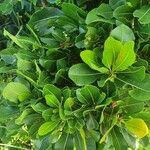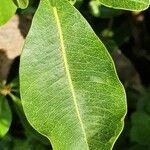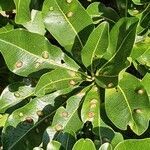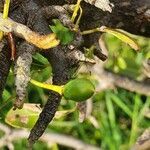Large shrub or tree, up to 15 m high, much branched, deciduous, with divaricate, subverticillate or zig-zag, often crooked branches, resembling several African species of Terminalia in habit; branches dimorphous; main shoots rather long, internodes usually 5-10 cm long; lateral short branches usually under 20 mm long; short shoots and apices of branches very rough with the scars of fallen leaves; youngest shoots at first pale yellowish-or whitish-tomentose, glabrescent. Leaves in rather dense, more or less fan-like spreading groups on the short lateral branches and terminal apices; young leaves almost completely glabrous as soon as they appear, the older ones quite glabrous; blade narrowly elliptic-obovate to narrowly spathulate-oblong, 1.5-6 cm long and 0.7-2.7 cm wide, coriaceous or subcoriaceous, apex usually emarginate or retuse, sometimes rounded, base narrowed, margin minutely reflexed, drying greyish green, paler beneath; midrib usually not very prominent on either side; petioles 2-4 mm rarely up to 7 mm long, flattened above. Flowers 3-merous, often appearing with the young leaves, or just before the leaves, pedicels and calyx greenish or green tinged with brown; pedicels 8-12 mm long, sparingly whitish pubescent. Sepals: outer ones ovate, sometimes oblong, 4-5 mm long and 2-2.5 mm wide, sparingly pubescent outside, pubescent inside near the apex and margins; inner ones more petaloid, oblong, 4-4.5 mm long and 2-2.5 mm wide, acute, tomentose outside, glabrous inside, vaguely midribbed. Corolla glabrous; tube about 1 mm long; lobes elliptic-lanceolate from a narrow base, obtuse or rounded, 0.5-0.75 mm wide. Staminodes variable in size but usually much shorter than the filaments, rather fleshy, subquadrate, ovate or spathulate, trilobed, tridentate, bifid or incised, occasionally produced at the apex into a long subulate or filamentous appendage. Filaments elongate-subulate, about 2.5 mm long; anthers oblong, apiculate, about 1.5 mm long. Ovary semiglobose-conical, about 1 mm high and about 1.5 mm in diameter, densely covered with rather long hairs; style 3 mm long, truncate. Berry ellipsoid or ellipsoid-obovoid, yellow when ripe, 10-12 mm long and 8-10 mm in diameter, 1-3-seeded. Seed brown, obovate-oblong or oblong, compressed, 8-11 mm long, 5-7 mm wide and 3-4 mm thick, subproduced at the base; testa brown, rather smooth, not very shiny, hard, scar basilateral, linear-elliptic or linear, 3-5 mm long and 0.5-1.5 mm wide, surrounded by a rather wide, pale brown, callus-like zone which includes the whole subproduced base of the seed.
Small to medium-sized tree with low branching and spreading crown, height up to 20 m., or sometimes a shrub.. Bark brownish-grey or blackish with longitudinal fissures.. Branching very irregular with leaves borne mainly in terminal rosettes on dwarf shoots, the latter usually swollen and with rough scarring; young shoots glabrescent or pubescent with evanescent ferrugineous indumentum.. Petioles l.5–12(–20) mm. long, glabrous or puberulous to pubescent especially when young.. Leaf-lamina coriaceous, elliptic-obovate to obovate, l.5–6.5(–7.5) cm. long, 0.8–3 cm. wide, apex rounded, often emarginate, base broadly to narrowly cuneate, in which case usually decurrent with petiole, or rarely ± rounded (especially in very shortly petiolate leaves), glabrous or puberulous to ± pubescent mainly on lower surface especially in young leaves; lateral nerves ± 10–14 on each side, nervation lightly impressed on both surfaces.. Flowers white to pale yellow, densely clustered in leaf axils.. Pedicels 6–13 mm. long, glabrous or with varying degrees of pubescence.. Calyx-lobes ± free to base; outer lobes ± ovate, 2.5–4 mm. long, 1.5–3 mm. wide, glabrescent to densely pubescent; inner lobes similar in shape but slightly smaller and pubescent externally.. Corolla-tube very short; lobes trifid; segments narrowly lanceolate or ligulate, 2–4 mm. long.. Filaments 1.5–2 mm. long; anthers 1–2 mm. long.. Staminodes small, truncate, apex irregularly toothed, rarely with one tooth enlarged and filament-like.. Ovary subglobose, shortly pilose, tapering at apex to a simple style, 2–3 mm. long.. Fruit yellow when mature with crimson soft edible pulp, subglobose to ellipsoid, up to 1.8 cm. long, 1.3 cm. in diameter, glabrous, containing 1–3 seeds.. Seeds dark brown, ellipsoid and compressed, up to 1.3 cm. long, 8 mm. wide; scar lateral, extending to base.
A shrub or small tree up to 4.5 m tall. It can grow to 15 m high. It loses its leaves during the year. The small branches are crooked and zigzag shaped. The leaves occur in tufts on knobbly side branches near the tips of branches. The leaves are oblong and hard and smooth. The tip is rounded and the base tapered. Leaves are 1.5-6 cm long by 0.7-2.8 cm wide. They are dull green. The leaf stalks are short. The flowers are small and yellow. They have a sweet smell. Flowers are either single or in clusters in the axils where leaves have fallen. The fruit are oval and 1.3 cm long. They are yellow when ripe. Fruit are edible. The seed is flattened and brown. It is paler at the base and has a scar on one side.
Leaves 1·8–9 x 1–3·4 cm., oblong, oblong–obovate or cordate, the apex rounded and emarginate, the base acute; petiole 1–10 mm. long. Upper leaf surface with midrib slightly raised and lateral veins level or impressed; lower surface with prominent midrib and veins level to strongly impressed; leaves often crispate–pubescent below and sometimes also sparsely pubescent above, patchily glabrescent.
Large shrub or tree, up to 15 m high. Twigs thick, conspicuously zigzag, divaricate or subverticillate. Leaves crowded in fan-like groups at tips of branches; glabrous. Pedicels 8-12 mm long, sparingly pubescent. Sepals sparsely pubescent outside. Flowers white to pale yellow or greenish yellow.
Staminodes very variable even within a single flower, ranging in shape from a small triangular or ovate–dentate scale to a long narrow process exceeding the stamen.
Corolla 3·6–4 mm. long, greenish– or brownish–yellow; basal tube c. 0·4 mm. long; median and lateral segments ± equal in shape and size, narrowly elliptic.
Branching subterminal, strongly divaricate, often subverticillate; leaves densely clustered at stem apices which are then overtopped by younger branches.
Evergreen tree or large bush 3–20 m. tall, with rough dark bark and pendulous branches, said to spread by suckering.
Flowers abundant, strongly scented, in fascicles of 3–4 per node; pedicels 5–7 mm. long.
Fruit up to 18 mm. long when ripe, ellipsoid, yellow with red pulp, edible, 1–3–seeded.
Calyx c. 3–5 mm. long, the sepals elliptic–ovate.
Gynoecium 2·8–3·6 mm. long.
Anthers 1·3–1·9 mm. long.
Seed 8–13 mm. long.





